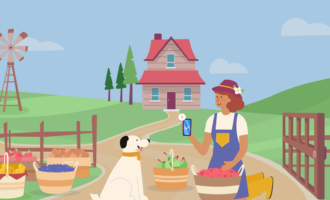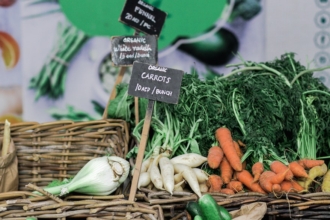COVID-19 triggered supply and demand challenges — and highlighted several problems of agricultural marketing for farmers. Topping the list is the reality that farmers need to be able to independently market their products directly to customers.
During the peak of the crisis, as grocery store shelves sat empty, the breakdown in the supply chain forced farmers to destroy their goods. It’s a situation that has left farms struggling to stay afloat.
Ching Lee, assistant editor at Ag Alert, reports that many farmers have had to rethink the way they do business and “look for alternative market avenues” to stay afloat. One farmer, James Birch, told Lee the new approaches to marketing were essential to his farm’s survival: “Our income went from many tens of thousands of dollars to nothing, and it wasn’t like we had money in the bank.”
Many farmers in situations similar to Birch’s are embarking on agricultural marketing endeavors that ensure a more direct pipeline to customers and long-term sustainability for their businesses.
But direct marketing is new for a lot of farmers who have long relied on intermediaries to bring their products to the marketplace. “In a sense, adding farm-direct marketing is the same as starting a small business in addition to your production work,” writes Larry Lev, a professor of applied economics at Oregon State University.
In other words, direct-to-consumer agricultural marketing comes with a steep learning curve. Here are four of the most common problems farmers face when trying to market their products directly to customers.
Pro Tip
Learn the ins and outs of agricultural marketing with our free agricultural marketing guide!
1. A lack of marketing skills and resources
Reaching customers is one of the most difficult parts of operating any business. Even experienced marketers have trouble conquering these challenges. Marketing isn’t cheap, either. It requires a significant investment of both time and money to be successful.
Embracing new marketing strategies will require farmers to reassess how they spend their time and money. They will have to make time to build marketing skills and execute marketing plans while maintaining their daily farm operations. They will also need to take a close look at the finances of their farm.
2. High levels of competition
According to data from Statista, there were over 2 million farms in the United States in 2019 (the definition of a farm is an operation that has $1,000 dollars or more in sales of agricultural products in a year). Throw in the smaller farms peppered throughout the country, and the options for customers to purchase agricultural goods are vast. This can make it very difficult for farmers to move into new markets or independently establish themselves.
That’s a big reason why farmers have made a push toward online selling.
3. Making the move to selling online
Because of restrictions on in-person interactions, the pandemic has compelled many farmers to move online to sell their goods. This could turn out to be a long-term boost for farmers. Lisa Held, senior policy reporter for Civil Eats, argues that “this moment presents a powerful opportunity for individual producers and local food aggregators to scale up their online presence.”
One of the biggest challenges in agricultural marketing for many farmers is building business models to incorporate direct-to-consumer marketing and shipping, notes Held. The other key challenge is creating an online presence through websites and social media pages to connect with and sell to customers.
Though these roadblocks are significant, there are benefits to overcoming them, such as an expanded customer reach and a lengthened selling season, Lev notes.
4. Logistical issues of getting products to customers
As farmers expand their reach so they can sell directly to consumers, other agricultural marketing problems emerge. These include storing products to maintain freshness and delivering fresh goods to customers. Agricultural products have a limited shelf life, which presents a short window for farmers to meet customers’ freshness expectations.
Combatting these issues may require investing in storage facilities and redesigning processes to ensure the freshness of products.
While solving these challenges in agricultural marketing may seem daunting, overcoming them can set farmers on the path to greater independence. In these uncertain times, as the world adjusts to a new normal, farmers should prioritize achieving self-reliance as a way to stay in business.


































































Send Comment:
3 Comments:
More than a year ago
research on marketing problems of agricultural product
More than a year ago
Good Information.Many problems of the farmer will be solved if we use agriculture robots, it will increase productivity.
More than a year ago
Thank you for allowing me to research